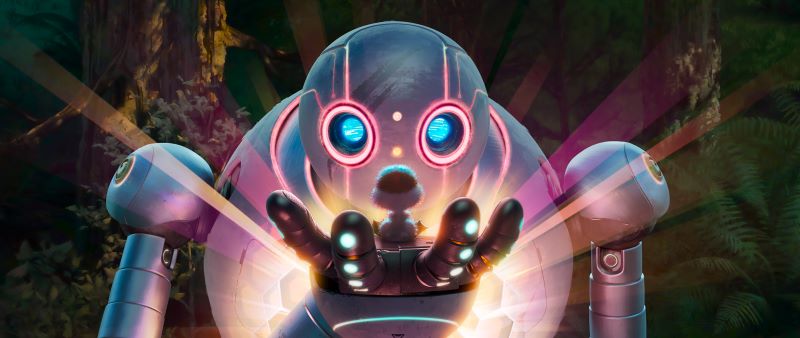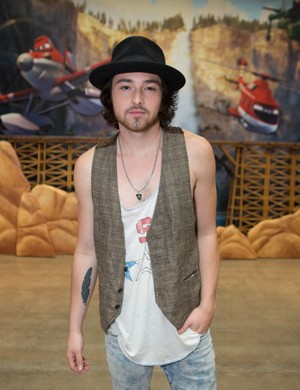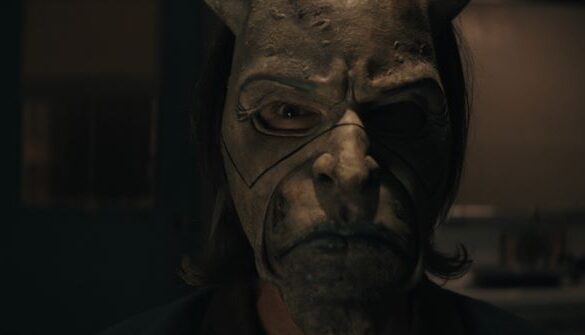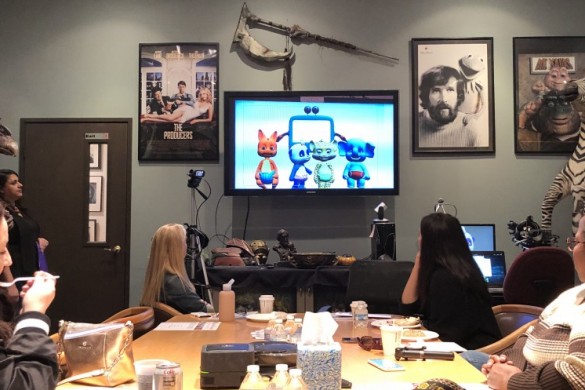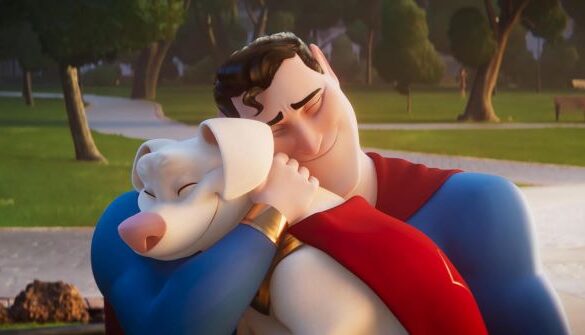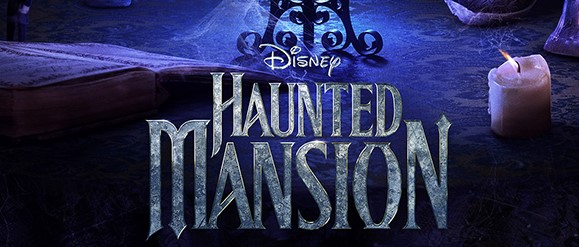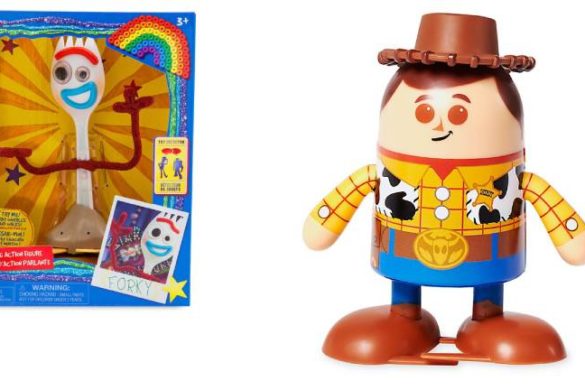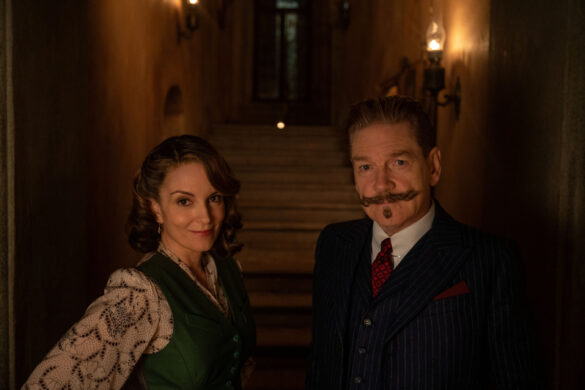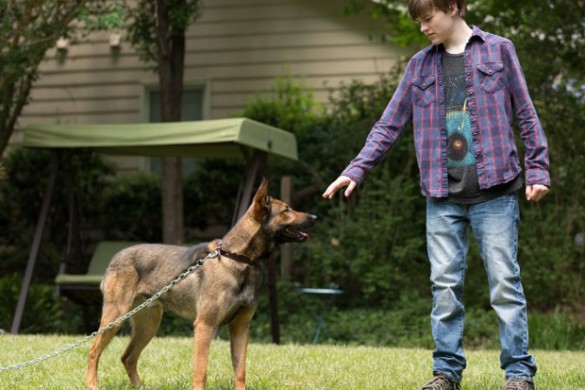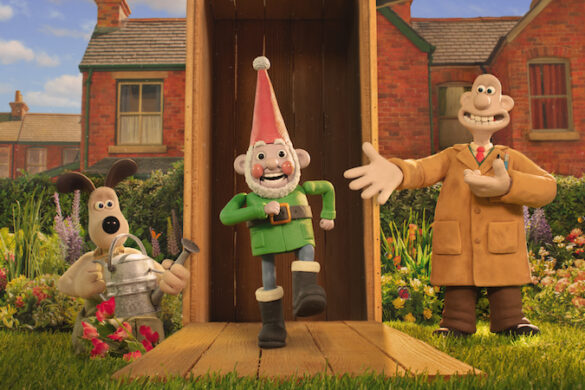“The Wild Robot’s” tagline,” Sometimes to survive, we must become more than we were programmed to be.” encompasses its themes of self-discovery and the juxtaposition of technology vs nature. Directed by Chris Sanders (“How to Train Your Dragon”), the film’s animation style echoes recent 2D and 3D animation hybrid greats like “Spider-Man: Across the Spider-Verse” and “Puss in Boots: The Last Wish” while still being able to reach new visual heights with its more character-driven story.
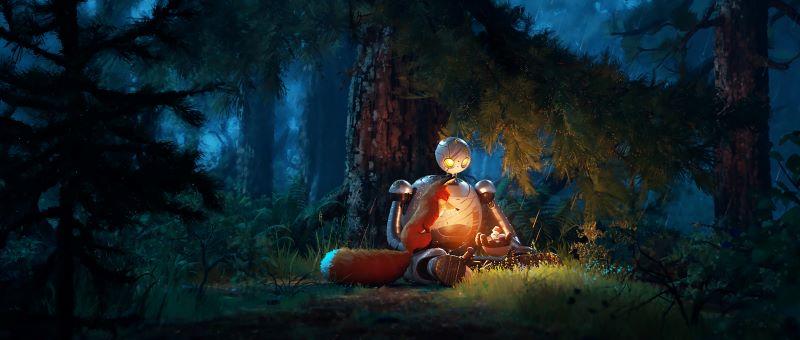
Dreamworks Animation’s latest feature is based on the book by Peter Brown, “The Wild Robot” follows a shipwrecked robot named Roz (Lupita Nyong’o) who awakens on an uninhabited island and quickly learns to adapt to her harsh and unforgiving natural home that hasn’t been perverted by the likes of man. She gradually building relationships with the animals on the island and becoming the adoptive parent of an orphaned gosling.
ThatsItLA joined their fellow journalists for a sneak preview of “The Wild Robot,” with Sanders and Nyong’o in attendance. There, we got to see over 30 minutes of the film, some of which were still a work in progress.
“The Wild Robot” opens with a shot of a wrecked package washing up on the shores of an uninhabited island. While it has yet to be activated, sea otters take notice and curiously investigate this foreign object. When one inadvertently steps on the button, Roz awakens and awaits to fulfill its primary directive of being a task robot. Upon its activation, Rosin 7134 congratulates whoever purchased her and promises to complete all requested tasks.
The otters don’t take too kindly to this technological marvel and look at it with disdain. When a giant wave starts to swell, all aquatic creatures swim away or climb up the rock face. Unable to adapt to its current conditions, the wave slams against Roz. When another wave starts, Roz sees a crab climbing up the rock face, and she modifies her hands and feet to mimic the crab. Having successfully avoided being hit by another wave, Roz lets the crab crawl onto her hand and asks if it needs assistance. However, it is quickly snatched away by a hungry seagull. An unaffected Roz then goes about her day in search of her owner.
Roz speaks to all the woodland critters searching for her owner while promoting the company. However, the animations refuse to give Roz a warm welcome. One even throws a pebble at it hoping it will go away. Instead, Roz offers it a sticker and a 10% off coupon. Thus, the search for her owner continues. As Roz traverses the forest, we start to see the juxtaposition between futuristic technology and the beauty of nature.
Rather than continue to struggle with communicating with these animals, Roz learns and adapts to their specific dialects. The use of technology to help break that language barrier helps ground the film, as it is comparable to how smartphones are used to translate other languages. Plus, it makes more sense in this context than resorting to animals that can speak human dialects.
The woodland creatures believe Roz to be dead, only to discover that “the monster” was in sleep mode learning the languages. Excited to speak to the animals, Roz announces her purpose to the forest community. A beaver says Roz isn’t helpful because she destroyed his dam, and the others add to the litany of problems she caused. When a creature asks if she is there to kill them and Roz responds no, the forest kingdom begins attacking her.
Without knowing it, Roz starts to feel lonely as she dejectedly asks, “Did anyone order me?” Figuring out that the delivery was unsuccessful, she climbs a tree to its highest point and uses a homing beacon so that her company can send a drone to pick her up. But the beacon acts as a lightning rod and draws in a bolt, which causes her system to temporarily shut down.
Once Roz reboots, she discovers that raccoons have taken her apart and are beginning to scamper. The individual pieces, like the hands, operate like a hive mind and are used to collect the stolen parts and return them to Roz. The raccoons stuck inside the chest cavity try to escape with other vital parts but do not. Though she can piece herself back together, she is still missing the transmitter. Without it, she can’t return home. When she finds the one raccoon that has it, she chases it to a tree. After successfully retrieving and activating the transmitter, the relentless raccoons still want the shiny transmitter and chase her up a tree, not knowing that the tree is starting to bend, with her acting as the counterweight. As Roz lowers herself down to the ground, she is the only thing keeping the tree from standing upright. The raccoons plead with her not to let go, but she does. As a result, these raccoons are catapulted into the night sky and splash down into the lagoon where she first awakened.
One raccoon with one more piece of Roz eluded the robot and took refuge in a cave. After Roz reclaims what was stolen, she is attacked by a bear. She’s no match for his fearsome strength; the loud roar only adds to the fright. She is beaten and battered during the ordeal and is unable to defend herself. The fact that you can get oriented and the sounds of metal being hammered by the bear’s immense power adds to the terror. It is only when Roz falls off a cliff and lands on a nest that the bear claims victory.
Though Roz is safe, she accidentally kills the mother goose and all but one of the eggs. The music is somber, and the darkness sets the tragic tone. As she searches through the destruction, the music slowly lifts into something hopeful, and Roz realizes her task is to protect this egg.
Of course, mothering in the wilderness, where there’s a predator-prey dynamic, can be challenging. Once Roz awakens, she notices a fox has eggnapped her egg. “May I confirm that is yours?” she asks the fox, who then runs away. The fox manages to take shelter in a hollowed-out log, hoping Roz won’t notice. This proves futile as Roz transforms her hands into buzzsaws and starts cutting the log.
Another chase ensues, with Roz and the fox exchanging claims over the egg. The fragile egg is in danger at times because it’s in midair and could crack if it hits the ground. Eventually, the fox gets the egg and leaps without looking only to land on a porcupine. Roz catches up and successfully retrieves the egg and apprehends the fox. Scared by the sight that Roz transformed her hands into saws and grinders, the Fox shuts its eyes and prepares for the worst. Roz uses a pair of tiny tweezers to pull out each quill.
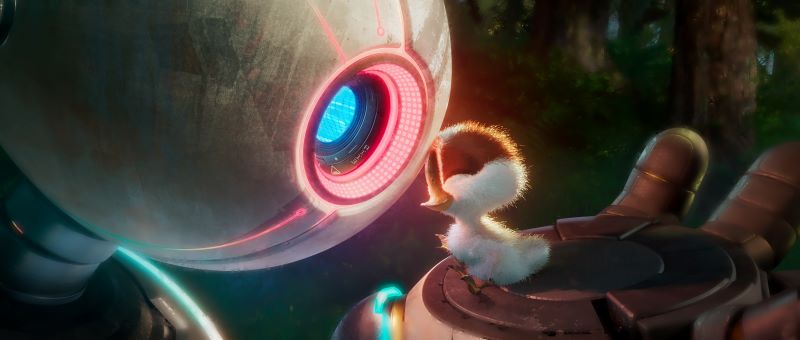
With the egg safe, Roz can continue her task until the egg starts to hatch. Again, Roz doesn’t understand her current situation, so when she sees the shell begin to crack, she believes she must keep it intact. Eventually, the hatchling breaks out of its shell and sees Roz. He immediately attaches himself to her, believing Roz is his mother.
The second clip occurs during the second act, raising the stakes significantly. Brightbill (Kit Connor) must learn to eat, swim, and fly independently by fall, or he will be trapped on the island with no food. Roz looks to Fink (Pedro Pascal) on how to teach Brightbill how to fly.
But because Roz and Fink need to learn how to fly, their lessons fall short of getting Brightbill to fly independently. At this point in the film, Brightbill learns the truth about what happened to his family and how Roz is his mother. The revelation strains their relationship. Brightbill wants nothing to do with Roz, but he reluctantly accepts her tutelage because the other members of the flock refuse to take on the responsibility of teaching Brightbill how to fly.
On the verge of breaking down because of a lack of maintenance, Roz looks to Longneck (Bill Nighy) for guidance. Though Longneck can’t help Roz teach Brighbill to fly, he tells her how she can get the young bird to tap into his limitless potential. Feeling inspired, Roz builds a makeshift runway for Brightbill. She strategizes a training session for him to develop the strength to liftoff and the endurance to fly for the long migration.
“The Wild Robot” has its own unique style as it blends 3D animation with 2D illustrative techniques together to bring Peter Brown’s work to life. Taking a cue from films like “Puss in Boots: Last Wish,” the film maintains an illustrative look while being inspired by the beauty of nature from Hayao Miyazaki’s My Neighbor Totoro and Princess Mononoke. The action itself is more reserved – at least with the portion of the film that we watched – allowing for a more character-driven piece to thrive. The approach makes Roz represent the technological wonders of the future set against the beauties of the forest that haven’t been perverted by modern man. Additionally, Roz is a robot with an expressionless face, and her voice having to convey the emotional. She also has great physical strength and durability, and yet, she is so tiny when compared to the forest, which is so much larger than she is and are dominating forces to be reckoned with.
“The performance comes out in the illustration. And I was very moved by how much was able to be conveyed without expression,” Nyong’o said. “Roz is face is two round holes and these coding blue eyes. And yet you get where she’s at. And you get the evolution of a programmed being into the wild robot that she becomes.”
The actor treated the film, despite it being animated, very seriously. “I don’t think we ever did a recording session where we didn’t dig into every moment in an incredibly positive and impressive way,” Sanders said about his sessions with Nyong’o. “You really kept us on track as far as her character and the character’s evolution.”
Nyong’o then talked about the challenges that came with voicing a robot that had no emotion. “If you think about this, like on a philosophical level, one of the things that make robots and artificial intelligence different from human beings is very fact that they don’t have emotion, everything is programmed,” she said. “Here we are telling a story about a robot that starts off in a very, very sophisticated structured program, sort of, quote, unquote, mentality. And then because of the demands of the wilderness, she has to adapt to a more organic sense of being.”
With robotics and artificial intelligence continuing the advance, another one of the challenges was how to find humanity in the voice while straying true to “the fact that she doesn’t have necessarily emotion.” “I think that was the the crux of the first and most crucial debate, and just making sure to painstakingly build on Roz’s understanding of this world that she exists in,” Nyong’o said. “One of her biggest powers is mimicry, right? And so how can you use mimicry to arrive at a semblance of emotion?”
Sanders was incredibly impressed with the subtlety Nyong’o was able to manifest in her voice. And because this is a robot who learns and adapts, Roz’s voice changes and evolves to become more than just a one-dimensional being. “One of the things that was really wonderful for us was to actually like, sit with your voice and just listen to all the different takes and and begin to sort out what is fitting and what is not,” he said about Nyong’o’s recording sessions.
“At the beginning of the film, I would say it was the greatest departure from my resting voice. And it’s where she’s the greenest, right. So she’s this sophisticated being, but on this island, she’s like a newborn baby She’s learning everything the first time. And so I was hoping to convey that sort of openness. And, I feel like that’s programmed optimism that these things like Siri and stuff, try to relay,” Nyong’o said. “So that high pitched, open, friendly, kind of non threatening female sound was what I was going for.” The actor said the approach was quite the vocal workout.
Still, Nyong’o loved that Sanders was open to the debate of how Roz should be voiced. “You were game to really get in there and figure out where and why and how. So that the change in her voice or evolution was based on the learning curve of the character, so less arbitrary and more, you know, as a result of an event or, you know, the stage of the relationship, the intimacy that she is forging with Brightbill,” she said.
According to Sanders, Brown revealed to them that one of the things that was never memorialized in the book was that kindness is a survival skill. “Roz has this unrelenting innocence and kindness. And it just won’t quit. And she and she begins to change the entire culture of the island. Because the island is life and death,” he said. Though Fink tells Roz that kindness is not a survival skill and the island is ruled by the law survival of the fittest.
When it came to accepting the role, Nyong’o had to ask herself a series of questions. “When I’m considering a new role, one of the things I asked myself is, what do I have this character? What do I have for free? Like, what do I just intrinsically understand? And don’t need to work out,” she said. “For me, it was compassion. Like the fact that her mission is compassionate. I was like, Yeah, I feel like I know that resonates with me and for me, and the thing about Roz is that she’s compassionate and frank.”
Nyong’o admits to being more emotionally open than she like to be and that it can be a burden at times. “To have so much access to my emotions because it means that I’m easily bruised, but I still stand in the belief that it was ultimately my power because it’s what makes acting a possible job for me to do,” she said. “It makes me feel I feel strongest when I can be honest about how I feel. And I feel strongest when I can be kind. Not nice, but kind.”
Nyong’o joked that sort of frankness does get her into trouble at times, especially in a place like Los Angeles. She recognized that we should say what we mean and mean what we say, and that things would be much easier that way. Of course, it doesn’t work out that way all the time, especially in different cultural settings. “I was cautious because I do have a capacity for honesty that rubs people the wrong way. If you if you have a certain kind of ego, then we can’t grow like we can’t. So the fact that this job takes some this is taking about three years,” she said about Sanders. “Three years. It’s like you have to be in relationship with people for a long time. And I really wanted to know that I could talk to you honestly.”
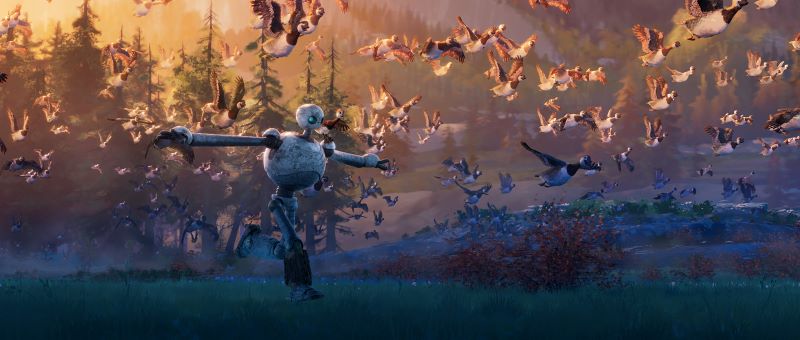
The entire animation process was new to Nyong’o but she knew about all of the “cool effects” that could be done in an animated film. “I just wanted to make sure that we were on the same page about what story we were hoping to tell, like, what is our true north,” she said. “That has to be human focused. And I could tell from your previous work that you have, like your, your finger on the pulse of humanity. So that wasn’t in question. But I wanted to know, how do you get there with everybody else?”
Nyong’o discovered that Sanders was open to her criticisms and questions and that he would integrate her suggestions into the film. “I never felt that he was catering to my ego. I never felt that he was trying to seduce me to join his project. For any other reason, then, he liked what I did, and believed in me and felt I would be a good fit,” she said. After signing on, only was the actor up for being in the recording booth for the next three years on her first day, she grew more confident when she saw how Sanders was receptive to her criticisms and questions. Sometimes she would have an idea, and the director would take it and make it better. “I remember leaving that session, feeling pumped. I felt like I had gained something. I given something by gain something. So I really loved working with you and for you,” she said.
“The Wild Robot” also features the voices of Catherine O’Hara and Stephanie Hsu, with Mark Hamill, Matt Berry, and Ving Rhames
“The Wild Robot” opens in theaters on September 27, 2024.

